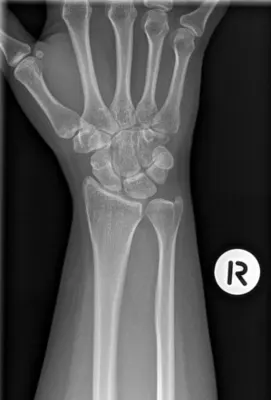How to interpret wrist X-rays: 3 Essential Methods
Introduction
Interpreting wrist X-rays is vital in orthopedics and emergency medicine, offering key insights for diagnosing and treating wrist-related issues. This guide introduces wrist X-rays and provides three crucial methods for their interpretation.
Understanding Wrist X-rays
A wrist X-ray is an essential imaging test that shows the bones, ligaments, and soft tissues of the wrist. This section will help you grasp the basics of wrist X-rays and their indications.

What Do Wrist X-rays Show?
- Bone Conditions: Detection of fractures, dislocations, and arthritis.
- Soft Tissue Status: Assessment of ligament injuries and soft tissue swelling.
- Growth and Development: Monitoring bone growth and development in children.
- Post-Surgical Evaluation: Evaluating the outcome of wrist surgeries.
When Will You Get One?
- Injury Assessment: Following wrist injuries, like falls or sports accidents.
- Chronic Pain Evaluation: For persistent wrist pain or limited mobility.
- Postoperative Monitoring: Checking the status post wrist surgery.
- Degenerative Disease Tracking: Monitoring conditions like osteoarthritis.
Methods to Interpret Wrist X-rays
Interpreting wrist X-rays involves different approaches based on expertise, requirements, and available resources. We explore three distinct methods suitable for various skill levels and scenarios.
1. Utilizing X-ray Interpreter
X-ray Interpreter offers quick, AI-based interpretations of wrist X-rays. Follow these steps for an AI-assisted analysis:
- Registration: Sign up on X-ray Interpreter for AI interpretations.
- Uploading X-rays: Upload your wrist X-ray images on the platform.
- Reviewing Interpretation: Examine the AI-generated report and download it.
- Professional Consultation: Consult medical professionals for clinical insights.
Check our get started guide.
2. Using ChatGPT Plus
ChatGPT Plus provides an interactive AI analysis of wrist X-ray images:
- Subscription: Access GPT-4V for image analysis with a ChatGPT Plus subscription.
- Uploading X-rays: Upload wrist X-rays on the OpenAI platform's GPT-4V interface.
- Analysis Request: Command or inquire for an X-ray analysis in natural language.
- Analysis Review: Evaluate the AI's analysis, refine if needed.
- Professional Validation: Confirm findings with medical professionals.
Read our article on using ChatGPT Plus for X-ray interpretation.
Alternatively, as several other AI models with vision capabilities emerge, you can also try other models, such as Grok by xAI, Claude by Anthropic, Gemini by Google Deepmind.
3. Reading Wrist X-rays Yourself
Self-reading wrist X-rays requires medical knowledge and continual learning:
- Education: Learn the basics of wrist X-ray interpretation through courses or resources.
- Practice: Interpret X-rays under expert guidance.
- Resources: Use books, online materials, and literature for skill enhancement.
- Feedback: Get feedback from experienced professionals.
- Ongoing Learning: Update skills with new medical research, workshops, and professional discussions.
Recommended Resources for Self-Reading:
-
Wrist X-ray Interpretation - OSCE Guide | Geeky Medics: This guide provides a step-by-step approach to interpreting wrist X-rays, covering key pathologies and the intricate anatomy of the wrist, including the mnemonic 'Some Lovers Try Positions That They Can't Handle' for the eight bones of the carpus.
-
Wrist x-rays - Don't Forget the Bubbles: Discussing the importance of wrist X-rays in children's emergency departments, this resource offers a systematic approach to interpreting these X-rays, particularly when suspecting injury to the distal radius/ulna or carpal bones.
These resources offer a range of materials for improving wrist X-ray interpretation skills.
Comparative Analysis
Choosing the appropriate method for wrist X-ray interpretation is crucial. This comparison of X-ray Interpreter, ChatGPT Plus, and Self-Reading evaluates each method based on accuracy, ease of use, cost, time efficiency, learning curve, and resource availability.
| Criteria | X-ray Interpreter | ChatGPT Plus | Self-Reading |
|---|---|---|---|
| Accuracy | Mostly High (AI-based)1 | Mostly High (AI-based)1 | Varies (Skill-dependent) |
| Ease of Use | Easy | Moderate | Challenging |
| Cost | Starting from $2.50 per image | $20 per month | Free (excluding educational costs) |
| Time Efficiency | Fast | Moderate to Fast | Slow to Moderate |
| Learning Curve | Low | Low to Moderate | High |
| Additional Resources | Provided | Partially Provided (through OpenAI) | Self-sourced |
Conclusion
Interpreting wrist X-rays is crucial for accurate diagnosis and treatment in orthopedic and emergency medicine. This guide has outlined three methods: X-ray Interpreter, ChatGPT Plus, and self-reading, each catering to different expertise levels and situations.
AI-based tools like X-ray Interpreter and ChatGPT Plus offer quick, accurate interpretations suitable for immediate insights, while self-reading is ideal for professionals enhancing their skills.
The comparative analysis helps in making informed decisions based on personal needs, technical ability, and resources. Continual learning and adhering to ethical practices are vital in utilizing these methods effectively.
This guide serves as a starting point in wrist X-ray interpretation, aiding in navigating this essential aspect of medical diagnostics.
Related Articles
Resources and Further Learning
For those interested in expanding their knowledge about wrist X-ray interpretation, the following resources are highly recommended:
-
Wrist X-Ray: Anatomy, Procedure & What to Expect | Cleveland Clinic: This resource offers an overview of the anatomy involved in wrist X-rays, the procedure, and what to expect during the test. It details the various conditions that can be diagnosed using a wrist X-ray, including fractures, dislocations, arthritis, carpal tunnel syndrome, and more.
-
Wrist series | Radiopaedia: Radiopaedia provides a comprehensive guide to wrist X-rays, including indications, standard projections, and additional views. This resource is particularly useful for understanding the posteroanterior, oblique, and lateral projections of the wrist, along with the specific bones and joints assessed in each view.
-
Wrist X-Ray Exam: A Guide for Parents | KidsHealth: KidsHealth offers a parent-friendly guide to understanding wrist X-rays in children. It includes information on why and how the procedure is conducted, what parents can expect, and how to prepare children for a wrist X-ray. This resource is especially valuable for parents looking to understand the process from a child-friendly perspective.
These resources provide varied perspectives and methods to enhance wrist X-ray interpretation skills.